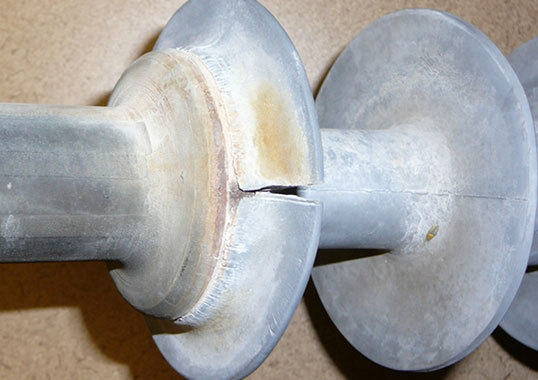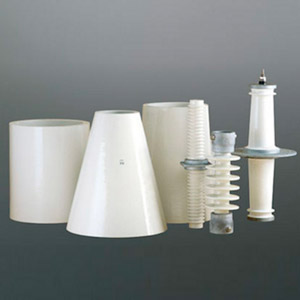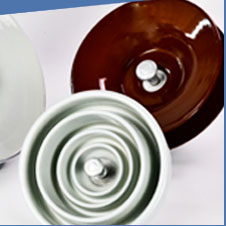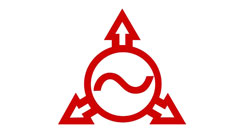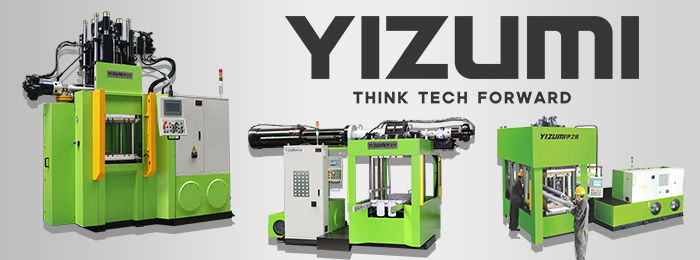Over the past 10 to 15 years, utilities in the United States and elsewhere experienced increasing failures of polymeric insulator on 115 and 138 kV transmission lines. Investigation showed that these failures could often be attributed to high electric field (E-field) occurring near or on the high-voltage end fittings. Such findings suggested that it was necessary to consider application of corona (grading) rings) on polymeric line insulators even at system voltage below 161 kV. This edited INMR article from 2013, contributed by Andrew Phillips and Chris Engelbrecht of EPRI, offered an overview of insulator failures and proposed strategies to manage the problem.
EPRI was one of the first research organizations to determine that high E-field and resulting discharge activity was an important contributor to premature ageing of polymeric insulators. Based on results from the multi-stress ageing chamber and other testing at the laboratory in Lenox, Massachusetts, this was identified as a primary ageing mechanism on 230 kV and 500 kV insulators. Appropriate E-field limits were subsequently established. More recently, insulator failures at 115 and 138 kV suggest that the same phenomenon may be present at lower system voltages as well.
Ageing of insulator sections subjected to local high electric field is usually the result of stresses associated with one or more of the following types of discharge activity:
• Continual corona activity from metallic end-fittings or grading rings under dry conditions;
• Discharges due to non-uniform wetting of the rubber material;
• Internal discharges, e.g. along the interface between the core and rubber housing or within the core itself.
Continuous corona activity from the metal end fittings can contain enough energy to directly cause erosion on rubber as well as loss of galvanization on metal end fittings.
On hydrophobic insulators individual drops or relatively limited water patches can enhance localized E-field by a factor of up to 12 due to the high permittivity of water (εr = 80). In the high E-field regions of the insulator, this enhancement could result in corona activity from the edge of the water. Research suggests that it is unlikely that water drop corona alone will result in significant degradation of the polymeric housing since temperature increase due to this type of corona is minimal. There is, however, ample evidence that the chemical by-products of corona – together with moisture – can result in serious material degradation. In this respect, formation of nitric acid is considered important. For example, it has been found that the pH on the surface of an insulator drops from an initial value of about 7 to 3.4 after only about 15 minutes of corona activity on a wet insulator surface. Moreover, it has been found that some formulations of silicone rubber can be particularly vulnerable to deterioration when exposed to nitric acid.
Available evidence suggests that water drop corona can be just the initial phase of the following, more severe, degradation mechanism that affects long-term insulator performance. Present understanding of this process is as follows:
1. Water drop corona in the high E-field regions results in localized loss of hydrophobicity. Regions affected have E-field magnitudes above the onset threshold for water drop corona (see Fig. 1).
2. Under wetting conditions, patches of surface water form in regions of lower hydrophobicity and are separated by dry regions or ‘bands’.
3. Localized arcs form, bridging gaps between water patches.
4. The energy and temperature of these localized arcs are significantly higher than that of water drop corona, further stressing the rubber.
5. With time, as affected regions lose hydrophobicity and completely wet out, E-field in the adjacent regions is enhanced above the water drop corona onset threshold under wetting conditions.
6. The ageing mechanism is then initiated in previously unaffected regions. In this manner, affected regions grow in size.
7. The by-products formed by corona in combination with water, notably nitric acid, can be aggressive on the housing, resulting in cracks or corrosion of end fittings.
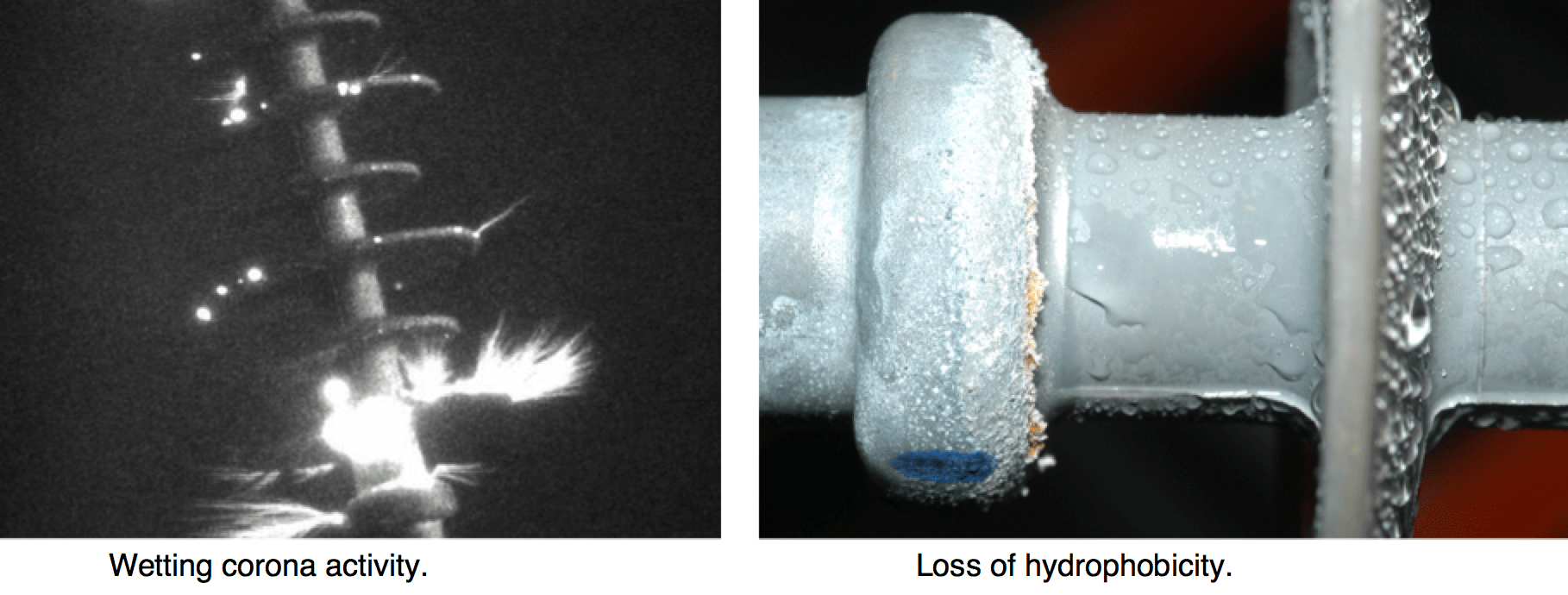
CLICK TO ENLARGE
During wetting conditions, the surface of hydrophilic composite insulators, such as EPDM, is more likely to become covered with patches of water rather than distinct droplets. Dry regions separate these patches and, due to E-field enhancement, sparking can occur between patches. These discharges contain more energy than corona and could degrade the rubber. Although such activity can also occur away from the high E-field region, casual observation during ageing tests suggests that it is more prevalent in regions with high E-field.
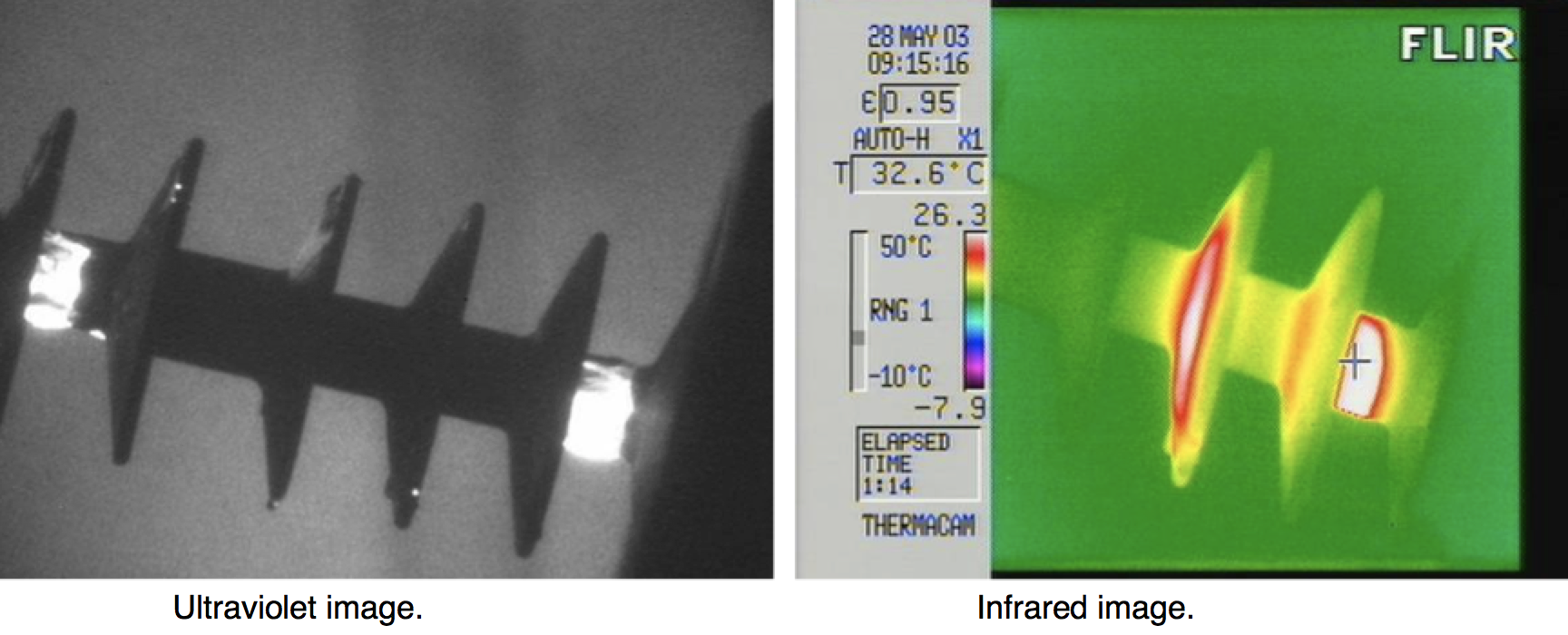
CLICK TO ENLARGE
Sufficiently high E-field magnitudes can lead to discharge activity within any internal defects, e.g. voids, inclusions ot poor bonding between sheath and core. This, in turn, could eventually lead to insulator failure either by destruction of the rod from discharge activity or by ‘flashunder’ (see Fig. 3).

CLICK TO ENLARGE
Research has shown that not all insulators are equally affected by high electric fields. Important factors that influence the rate and level of degradation include:
• Type of rubber and design of the weathershed system;
• Design of end fitting seal;
• Level, location and type of discharge activity, which is determined to a large extent by E-field along the insulator, type and intensity of wetting, presence of contaminants and level of hydrophobicity of material.
Service Experience
The occurrence of 5 insulator failures several years ago on 115 kV and 138 kV lines prompted three utilities in the U.S. to initiate a study to better understand ageing mechanisms on insulators of this voltage class. As evident from EPRI’s failure database at the time (see Fig. 4), these failures were not isolated but rather part of a trend of increasing failures reported on 115 kV to 138 kV insulators. Data show that, on average, 7 failures/year were reported to EPRI since 1998.
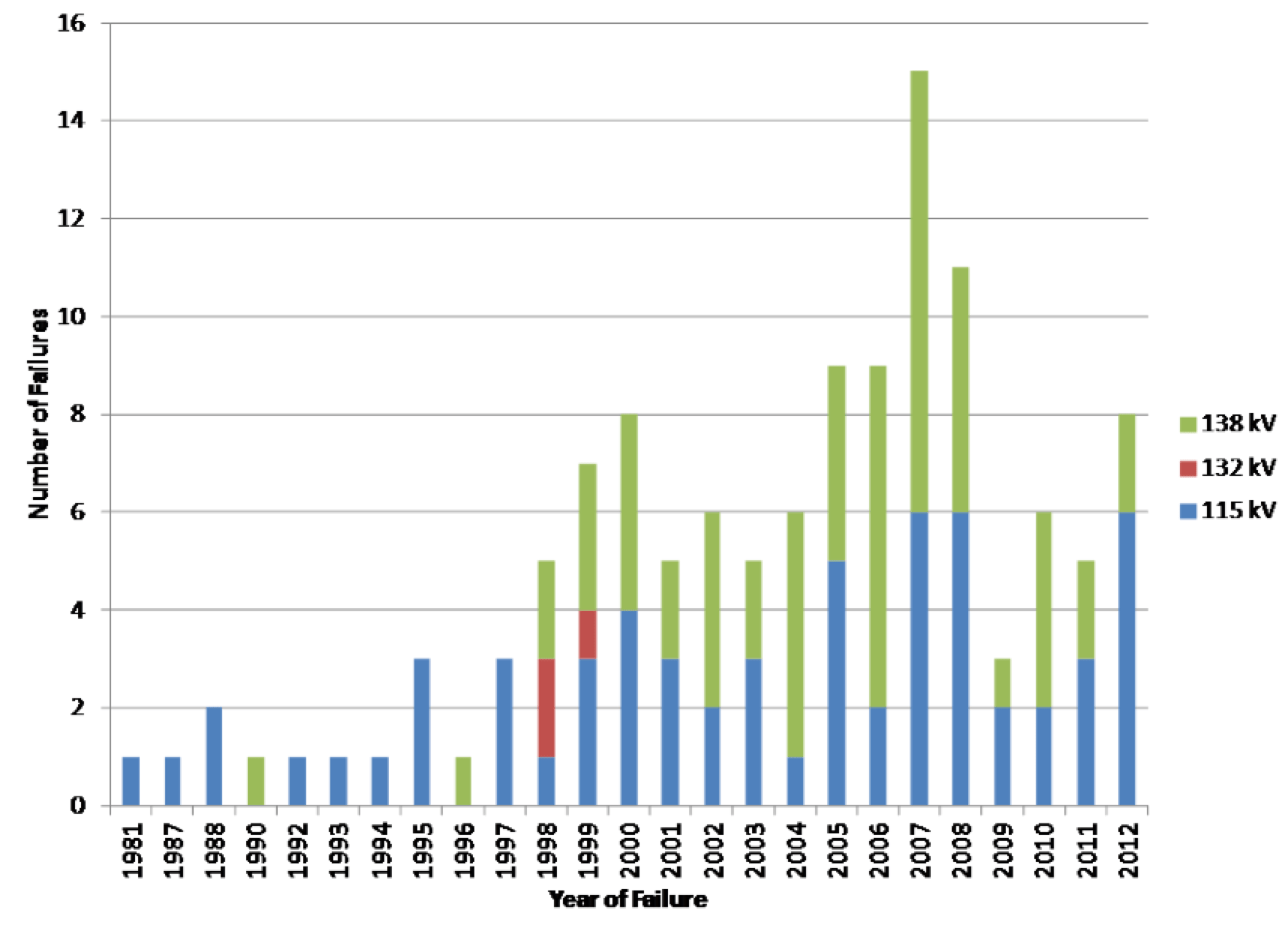
CLICK TO ENLARGE
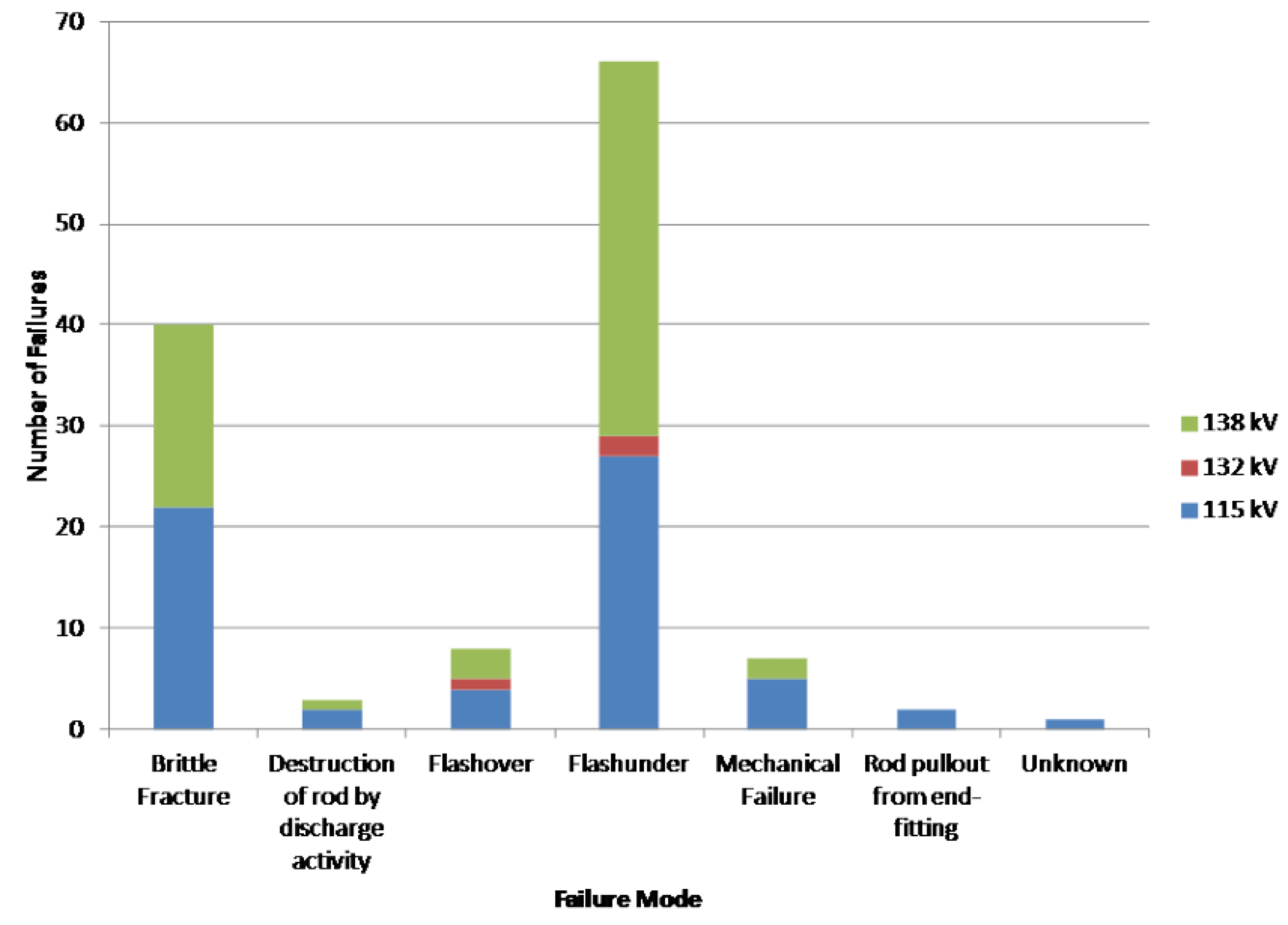
CLICK TO ENLARGE
Breakdown of failure modes of the 140 failures recorded in the EPRI database for of 115 kV to 138 kV insulators is presented in Fig. 5. From this it can be seen that the dominant failure modes were stress corrosion cracking (brittle fracture) and flashunder. A large proportion of these failures were on the same insulator design and specifically on units manufactured between 1993 and 1999.
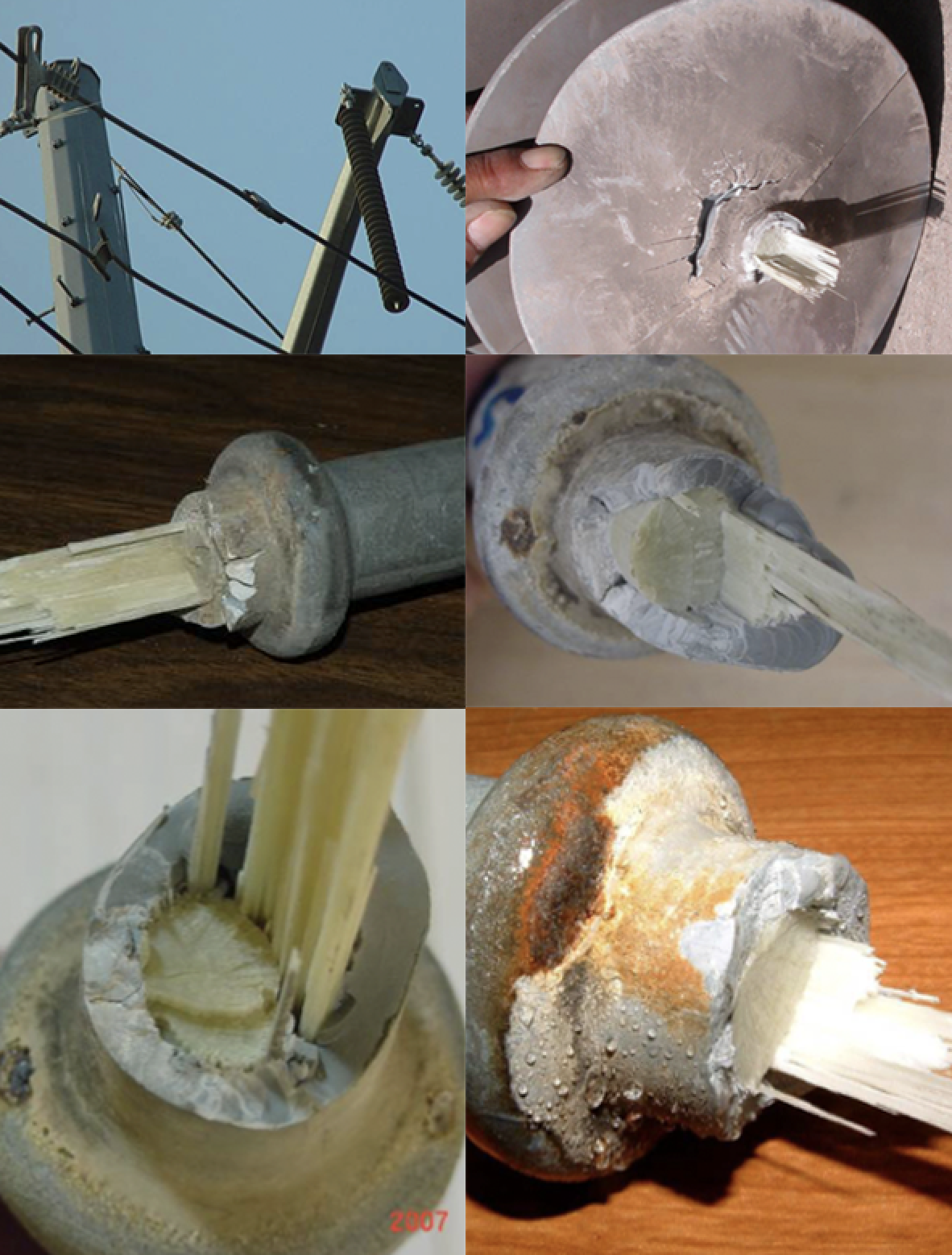
CLICK TO ENLARGE
During the investigation, it was shown that all such failures could be attributed to continuous discharge activity from the end fitting under dry conditions. This continuing exposure to corona resulted in cracks in the rubber sheath and degradation of the end fitting seal. Once a seal is compromised, moisture can come into contact with the fiberglass rod, leading to brittle fracture. Brittle fracture is a mechanical failure of the rod due to acid attack and where the fracture exhibits one or more smooth, planar surfaces – mainly perpendicular to the axis of the rod and giving the appearance of the rod being cut.
As consequence of these failures, utilities were forced to re-examine the use of corona rings (or lack thereof) on 115/138 kV polymeric insulators. In cooperation with EPRI, utilities have therefore initiated a number of specific activities since 2007 to assess risk to 115/138 kV polymeric insulators from premature ageing due to high electric fields. These included:
• Daylight discharge inspections;
• Detailed examination of insulators taken from service, failure investigations, and;
• E-field calculations.
These activities focused mainly on the particular design that suffered most failures.
Daylight Discharge Inspections
EPRI and 5 utility members together performed daytime discharge inspections on twelve 115 and 138 kV transmission lines to determine whether continuous discharge activity was occurring from end fittings under dry conditions. While these inspections were primarily directed towards one particular design, there were also opportunities to inspect a limited number of other designs. Examples of corona observations are presented in Fig. 7.
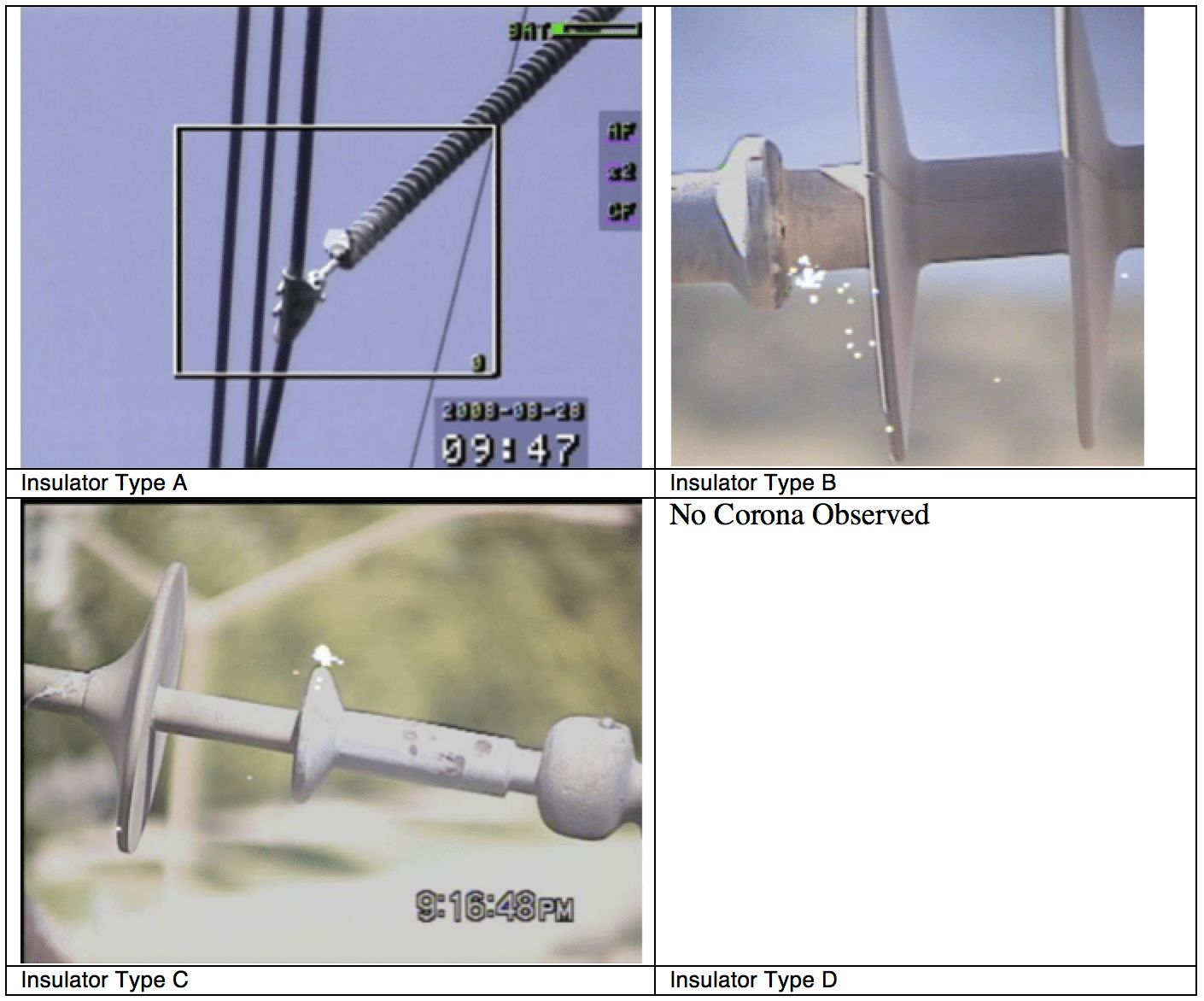
CLICK TO ENLARGE
Conclusions from these inspections were:
• Corona discharge activity under dry conditions was observed on the end fittings of composite insulators installed on all twelve 115 kV and 138 kV transmission lines inspected, though not all insulators had corona activity;
• Corona discharges were more likely on dead-end strings and least on brace post configurations. This is not unexpected as it is known from previous calculations that E-field is generally higher for dead-end insulators than for suspension units or brace post configurations;
• To date, corona activity has been observed on 3 of the 4 insulator designs from different manufacturers (see Fig. 7);
• In one case, daylight corona observations were made before and after installation of a corona ring. This confirmed that addition of the ring eliminated corona from the end fitting.
Detailed Inspection
EPRI worked with 5 utilities to evaluate degradation on over 200 units of 115 and 138 kV insulators removed from service. All had been installed between 1994 and 2006, without corona rings, and were of the same design. 74 insulators removed from service were subjected to detailed examination comprising a (1) visual inspection, (2) hydrophobicity measurement, (2) dye penetration test, (3) dissection and, in some cases, (4) mechanical testing. The remaining units were evaluated only with visual inspection. In all cases it was found that the most severe degradation was observed in the same regions, i.e. where dry corona activity was seen during daylight discharge inspections. On some units it was found that degradation of the sheath and end fitting seal had progressed to the point that the rod was exposed to the environment. These were considered as high-risk units where failure was inevitable.
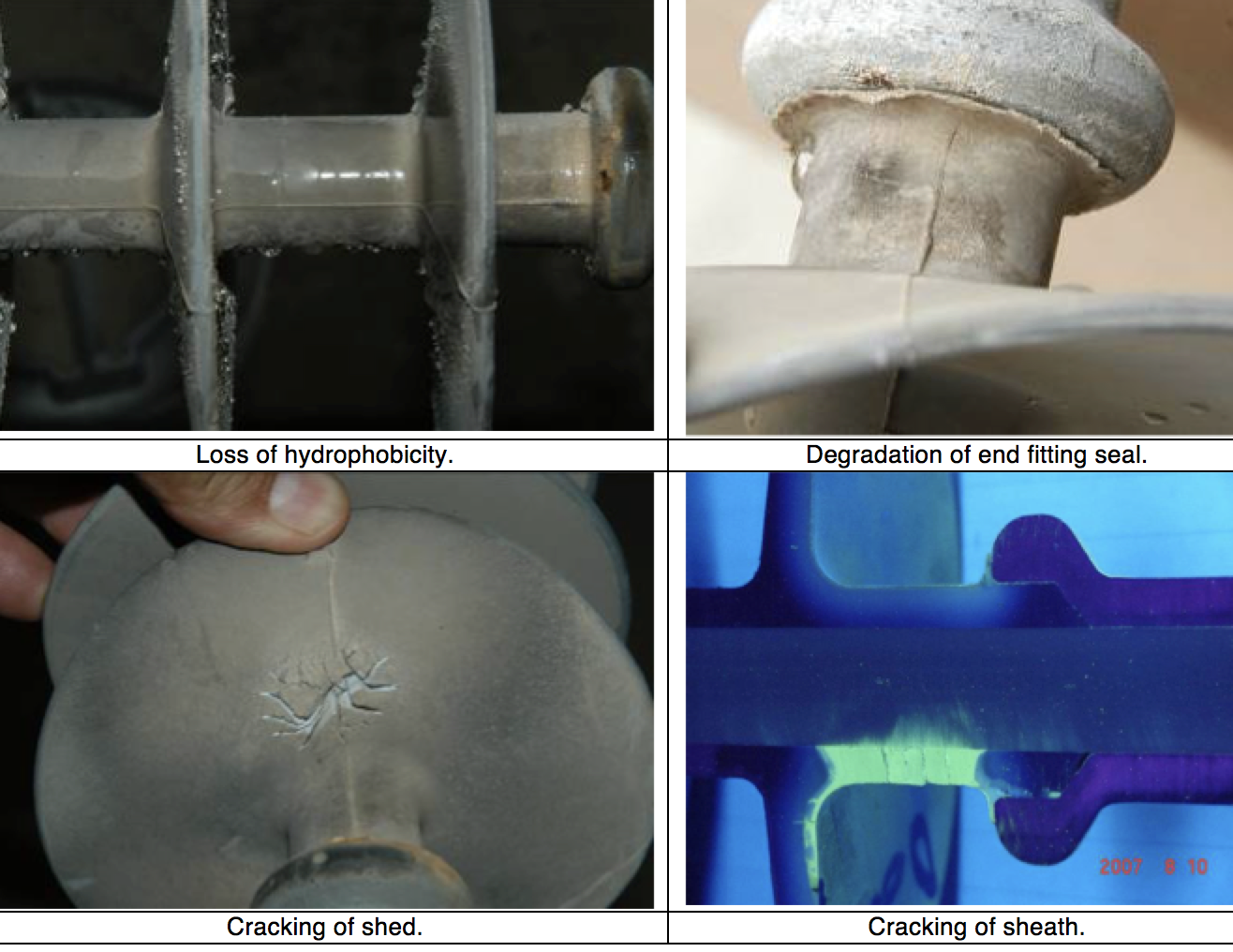
CLICK TO ENLARGE
E-Field Calculations
Extensive 3-D E-field calculations were performed on behalf of 4 utilities at both 115 and 138 kV. The goal was to obtain a better understanding of expected E-field distribution on 115 and 138 kV insulators as well as the parameters that influence it and also to evaluate possible remedial measures. Importantly, E-field calculations were made to account for the presence of all three phases (and in some cases even adjacent circuits) on structures. Calculations focused on structures where failures had already occurred or where corona has been observed. These calculations considered both E-field on end-fittings (to indicate likelihood of dry corona) and along the sheath (to indicate the likelihood for water induced corona). The following conclusions were drawn:
• Dead-end insulators have higher E-field magnitudes than suspension insulators;
• Single dead-end insulators have higher E-field magnitudes than double dead-end insulators;
• Addition of a hot line link results in slightly higher E-field magnitude on the insulator;
• There is a significant difference in E-field levels between different insulator designs (see Fig. 9). Small and slender end fittings tend to have higher E-fields in the region of the end fitting seal. Shape of end fitting dictates where the highest field occurs and accordingly whether or not any dry corona present will be in contact with the housing material;
• E-field magnitudes exceeded EPRI recommended limits on all designs of 115 and 138 kV polymeric insulators installed without corona rings;
• Addition of 8” corona rings at the live end of the insulator was in most cases sufficient to reduce E-field magnitudes to an acceptable level;
• Results of E-field modeling combined with corona camera inspection confirmed that failures that occurred on 115 and 138 kV insulators as well as degradation observed could be associated with high E-fields on the insulators;
• E-field limits need to be adjusted downward for insulators installed at high altitude i.e. above 3300 ft (1000 m).
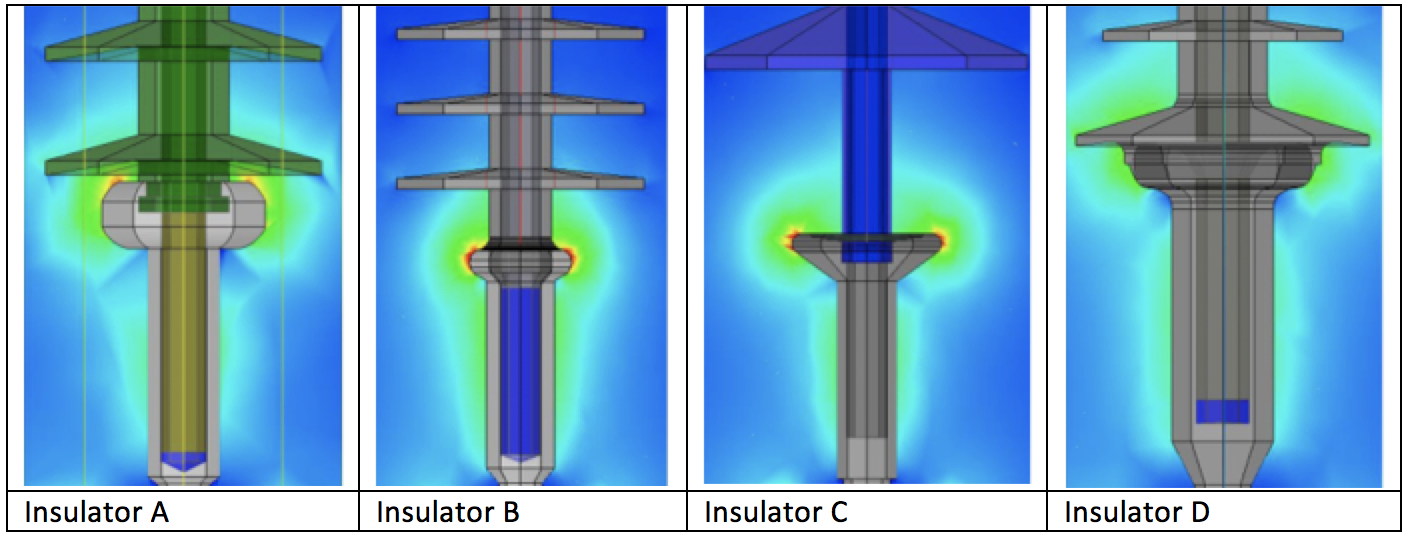
CLICK TO ENLARGE
Population Assessment
Service experience strongly suggests the need for corona rings on 115 kV and 138 kV polymeric insulators to protect them from premature ageing due to corona activity. Although this conclusion may seem simple, the implications could be quite profound, especially if large numbers of such insulators are already in-service. Utilities would then be faced with the challenge of identifying high-risk units and deciding the most appropriate and cost effective remedial actions. Fortunately, deterioration due to corona discharge activity develops slowly and this gives utilities time to conduct proper condition assessment.
EPRI has helped develop a population assessment strategy to address premature ageing of polymeric insulators on 115 and 138 kV lines due to high E-field. Key in this strategy is a set of tools that includes field guides, failure databases, E-field modeling techniques, corona inspection technologies and relevant accelerated ageing test results. An overview of the process is shown in Fig. 10.
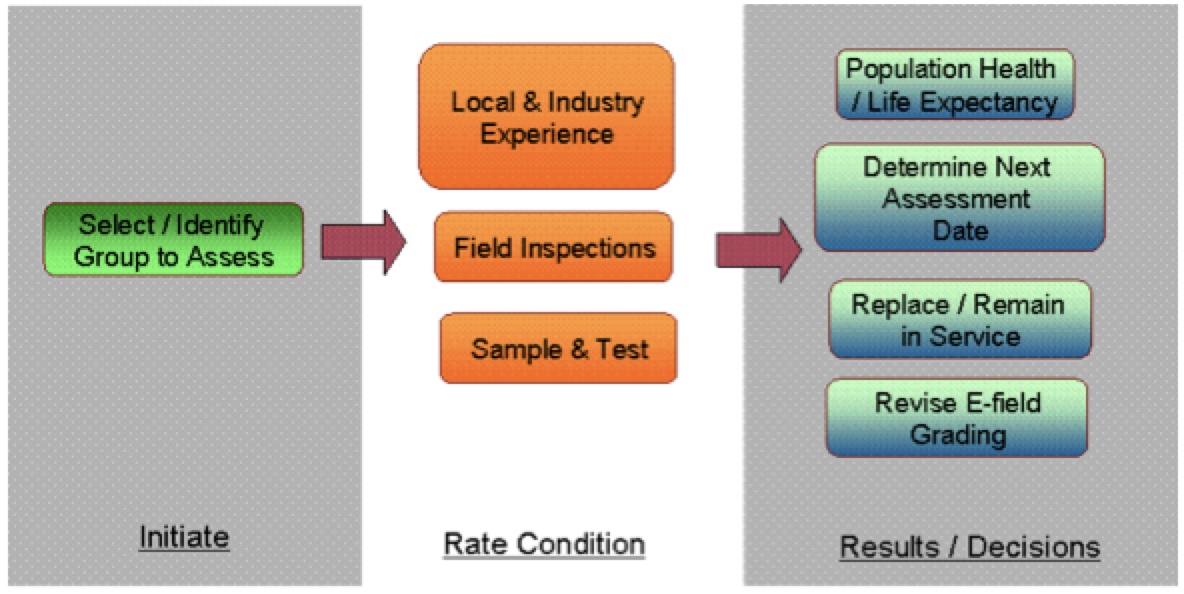
CLICK TO ENLARGE
Conclusions
Since 2006 there has been an increasing number of polymeric insulator failures recorded on 115 and 138 kV overhead lines. These failures were serious since they occurred mostly on critical dead-end insulators that pose a threat to system integrity due to risk of a downed conductor. Investigation results suggest that these failures are due to high electric fields (E-fields) occurring close to or on the high voltage end fittings of these insulators. Consequently, corona or grading rings may also be necessary for polymeric insulators installed at these voltage levels.
Levels of dry corona activity from end fittings that occurred in-service were higher than expected based on laboratory testing. E-field modeling offered two explanations:
1. At 115 and 138 kV, proximity of nearby phases significantly increases surface E-field magnitudes;
2. Most laboratory testing is done on suspension configurations but E-field magnitudes on dead-end and hard angle insulators are higher.

